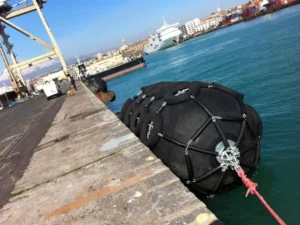In de maritieme sector zijn stootwillen van het grootste belang. Het gebruik ervan is een redding voor booteigenaren en loodsen van schepen. Zonder stootwillen is de reis van het schip onmogelijk. Er zijn echter verschillende soorten stootwillen beschikbaar, en rubberen stootwillen zijn er daar één van. Maar de vraag is: wat zijn rubberen stootkussens en waarom zijn ze zo populair?
Ik begrijp dat deze vraag goed begrepen wordt door velen die verbonden zijn met de maritieme industrie. Maar sommige beginners op dit gebied lijken in de war te zijn. Zelfs als je een liefhebber bent van de watersport, weet je dan wat de reden is achter de populariteit van deze stootwillen? Ik wed van niet! Dus laten we beginnen en de rubberen stootkussens in detail bespreken.
Overzicht van rubberen spatborden

Rubberen stootwillen zijn net bumpers, maar dan voor boten, schepen en vaartuigen. Ze fungeren als beveiligers voor schepen en beschermen ze tegen schade tijdens het aanmeren. Deze stootwillen zijn gemaakt van rubber en blijven rond het schip hangen. Ze botsen tegen de aanmeerstructuur en absorberen de impact.
Er zijn verschillende soorten rubberen stootwillen beschikbaar voor schepen. Ze dienen echter allemaal hetzelfde doel: het beschermen van schepen. Hoewel de kwaliteit per type verschilt, heeft elk type unieke kenmerken. Ze zijn gemaakt voor schepen van verschillende afmetingen en hoogtes.
Het gebruik ervan is wijdverspreid en gaat vele decennia terug. In het verleden was hout het primaire materiaal dat wordt gebruikt om spatborden te maken. Maar die spatborden van hout waren niet erg effectief. De reden hiervoor is dat hout geen schokken absorbeert, waardoor de effectiviteit in het gedrang kwam.
De introductie van rubber in de spatborden blijkt handig te zijn. De reden hiervoor is dat dit materiaal schokken absorbeert. Wanneer een schip in botsing komt met een aanmeerstructuur, absorberen deze rubberen stootwillen de kinetische energie. Hierdoor krijgt de boot niet te maken met schokken of plotselinge schokken. Bovendien blijven de zijkanten van schepen veilig als de stootwillen eerst de aanlegconstructies raken.
Korte samenvatting: Rubber fenders zijn vooral bedoeld om schepen te redden. Dat doen ze op twee manieren. Ten eerste absorberen ze schokken, wat een groot pluspunt is. Ten tweede botsen ze eerst tegen aanmeerstructuren zodat de romp van het schip veilig blijft voor botsingen op snelheid.
Kenmerken van rubberen spatborden

In de inleiding zei ik dat deze spatborden trendy zijn. De vraag is, WAAROM? Het antwoord op deze vraag hangt samen met de eigenschappen van deze spatborden. Laten we dieper duiken en de kritieke eigenschappen van deze spatborden onderzoeken. Als je ze begrijpt, weet je waarom ze zo trendy zijn.
1- Elasticiteit
Ten eerste is rubber zeer elastisch. Als je het krachtig uitrekt, neemt het zijn oorspronkelijke vorm weer aan en vervormt het niet blijvend. Dit komt door de lange keten van polymeren, die zeer flexibel is. Wanneer rubber wordt gebruikt in spatborden, worden ze elastisch. Dankzij deze elasticiteit kunnen ze gemakkelijk energie absorberen en afvoeren.
Stel je een schip voor dat aanlegt bij de dokstructuren. Het komt met enige snelheid. Bij het naderen botsen de fenders eerst tegen de dokstructuren. Door de botsing produceren ze kinetische energie. De rubberen stootwillen absorberen alle energie en worden vervormd en samengedrukt.
Deze vervorming of samendrukking van rubberen stootwillen is echter geen groot probleem. Dankzij hun elasticiteit krijgen deze stootwillen hun oorspronkelijke vorm gemakkelijk terug. Bovendien beschermen ze de aanlegstructuren tegen schade.
2- Duurzaamheid en weerstand
De rubberen stootwillen blijven in het zoute water. Het zal niet verkeerd zijn dat ze een groot deel van hun leven in het water doorbrengen. Bovendien hebben ze te maken met extreme weersomstandigheden. Hoe kunnen we vergeten dat ze worden blootgesteld aan extreem zonlicht en UV-stralen? Als ze op een schip zijn geïnstalleerd, worden ze blootgesteld aan zware omstandigheden.
Maar ze blijven in goede staat zonder achteruit te gaan. De reden hiervoor is dat het rubber dat in deze spatborden wordt gebruikt van de hoogste kwaliteit is. Het is uitstekend bestand tegen verschillende omgevingsomstandigheden. Maar je moet altijd koop spatborden van een gerenommeerde fabrikant.
Het zal je helpen om solide en betrouwbare spatborden te kopen die gemaakt zijn van hoogwaardig materiaal. Val niet ten prooi aan goedkope fabrikanten die concessies doen aan de kwaliteit. Als je dat doet, krijg je hoofdpijn en loopt je geld voortdurend gevaar.
3- Treksterkte
Treksterkte is een cruciale eigenschap die ze erg populair maakt. Laten we eerst begrijpen wat deze term betekent. Het is de maximale kracht die een materiaal kan verdragen zonder te verslechteren of te breken. Rubberen spatborden hebben een hoge treksterkte, waardoor ze opvallen bij zware botsingen.
Als het schip bijvoorbeeld met hoge snelheid een dok nadert, krijgen de stootwillen vaker te maken met botsingen. In zulke gevallen komt de hoge treksterkte goed van pas. Hierdoor kunnen stootwillen vervormen en toch niet breken of verslechteren. Het resultaat is dat de spatborden in goede vorm blijven, zelfs na zo'n heftige botsing. Deze eigenschappen maken rubberen spatborden zeer prominent.
4- Ingestelde compressieweerstand
Dit is een ander opvallend kenmerk waardoor rubberen spatborden opvallen. Laten we eens begrijpen wat deze eigenschap betekent. Het geeft simpelweg het herstel van spatborden aan nadat ze langere tijd zijn samengedrukt. Sommige rubbers zijn van lage kwaliteit, waardoor ze vast komen te zitten en vervormen als ze langer worden samengedrukt.
Dit beïnvloedt de prestaties van de rubberen spatborden. Daarom benadruk ik altijd het kiezen van spatborden met rubber van hoge kwaliteit. Dergelijke rubberen spatborden kunnen hun vorm terugkrijgen, hoe lang ze ook samengedrukt blijven. Deze eigenschap maakt de rubberen spatborden klaar voor de zwaarste schokken en stoten. Het rubber van de spatborden komt niet vast te zitten tijdens een botsing.
Werken van rubberen spatborden
Rubberen stootwillen werken op basis van twee kenmerken: elasticiteit en treksterkte. Rubber met een verminderde elasticiteit zal nooit goed presteren als het wordt gebruikt in deze fenders. Houd er rekening mee dat deze stootwillen kunnen worden geïnstalleerd op dokstructuren en schepen.
Laten we eens begrijpen hoe deze rubberen stootwillen werken. Het schip nadert de dokstructuren voor zijn verblijf. Het komt met enige snelheid naar het dok toe. Als het schip snel tegen het dok botst, raken zowel het schip als het dok beschadigd door de botsing.
Deze fenders op het schip fungeren als barrières. Ze voorkomen directe aanvaringen van schepen met dokken. Wanneer de boot het dok nadert, botst de rubberen stootwil tegen de structuur van het dok. Houd er rekening mee dat fenders samendrukbaar en elastisch zijn. Ze absorberen dus de impact van een aanvaring door de kinetische energie te absorberen.
De stootwillen voeren de energie vervolgens af. Omdat ze de impact absorberen, voelt het schip geen grote schokken en blijft het veilig. Door hun elastische aard worden de stootwillen samengedrukt en nemen ze hun oorspronkelijke vorm weer aan. Op deze manier spelen deze rubberen stootwillen een integrale rol in de scheepvaartindustrie.
Typen rubberen spatborden

Er zijn verschillende soorten rubberen spatborden. Ze verschillen allemaal qua eigenschappen en prestaties. Bovendien verschilt ook het installatieproces van rubberen stootkussens aanzienlijk. Hier volgt een lijst van die types:
- D-Type Spatborden
- Super Cel Spatborden
- Super Boogspatborden
- ME Rubberen spatborden
- Super kegel spatborden
- Cilindrische Rubber Spatborden
Al deze spatborden hebben dezelfde functionaliteit. Hun eigenschappen en werking maken ze echter verschillend. Zoals eerder vermeld hebben alle rubberen stootwillen unieke vormen en maten, waardoor ze geschikt zijn voor verschillende schepen en vaartuigen.
Zijn boeien en stootwillen hetzelfde?
Nee, boeien en stootkussens zijn niet hetzelfde. Ze dienen verschillende doelen. Stootkussens zijn veiligheidsbumpers die het schip beschermen wanneer het tegen het dok botst. Anderzijds zijn boeien waarschuwingsborden die een veilige doorgang op zee aangeven.
Boeien worden meestal gebruikt als het schip op zee moet blijven. Ze worden verankerd in de zeebodem en houden de boot op één plek. Kapiteins gebruiken boeien meestal tijdens stormen en slechte weersomstandigheden. Dit helpt hen om de schepen op één punt te houden. Er zijn verschillende soorten boeien beschikbaar voor boten.
Stootwillen zijn anders dan boeien. Ze worden aan de zijkanten van schepen geïnstalleerd. Ze kunnen worden verwijderd en in de boot worden geplaatst als ze niet worden gebruikt. Tijdens het aanmeren zorgen ze voor de veiligheid van schepen. Net als boeien zijn er ook veel soorten stootwillen.
Veelgestelde vragen
Van welk materiaal is Fender gemaakt?
Rubber is het belangrijkste materiaal voor de meeste spatborden. Over het algemeen is dit materiaal uitstekend geschikt voor het absorberen van de kinetische energie die vrijkomt tijdens een botsing. Wat het populair maakt, is de kosteneffectiviteit.
Wat zijn rubberen spatborden?
Het zijn beschermende onderdelen die op schepen worden geïnstalleerd. Ze zijn elastisch en gemaakt van rubber. Ze onderscheiden zich door hun vermogen om schokken en stoten te absorberen.
Wat is het beste materiaal voor spatborden?
Er zijn verschillende materialen beschikbaar voor het maken van stootwillen. Ik vind rubber echter het beste materiaal voor stootwillen voor de scheepvaart. Het is goedkoop en efficiënt en onderscheidt zich door zijn elasticiteit en treksterkte.
Zijn spatborden voor auto's en boten verschillend?
Ja, voorspatborden bestaan meestal uit plastic. Ze zijn breekbaar en niet bestand tegen schokken. Zeespatborden daarentegen zijn robuust en duurzaam. Ze zijn perfect om extreme kracht en druk met gemak te dragen.
Waarvoor dienen spatbordhoezen en wanneer moeten ze worden gebruikt?
Spatbordafdekkingen beschermen de spatborden en fungeren als een extra schild of veiligheidslaag. Dankzij de covers kunnen zonlicht en UV-blootstelling de rubberen kwaliteit van deze spatborden niet aantasten.
Conclusie
Rubberen stootwillen zijn op veel manieren super handig. Ze beschermen zowel het schip als de aanmeerstructuur zonder te verslechteren. Hun uitstekende elasticiteit en treksterkte zorgen ervoor dat ze efficiënt werken. Er zijn verschillende soorten rubberen stootwillen en ze zijn allemaal heel specifiek. Deze gids gaat in op elk detail van deze stootwillen. Dit stuk zal een leidraad blijken te zijn.
